Nescot College: L/508/0566 Unit 29 - Small Business Management Toolkit
VerifiedAdded on 2022/11/28
|18
|4836
|115
Report
AI Summary
This report provides a detailed toolkit for managing small businesses, covering critical aspects like resource allocation, customer relationship management (CRM), transnational business development, and financial planning. The report explores the importance of effective resource allocation for achieving business objectives, emphasizing the need to identify required resources, prioritize projects, and utilize employee skills efficiently. It also evaluates CRM processes, highlighting the five-step approach to generate brand awareness, acquire leads, convert leads into customers, provide superior support, and drive up sales. Furthermore, the report discusses how small businesses can develop transnational strategies, examining the benefits and drawbacks of joint ventures and licensing. Financial considerations are addressed through the creation of a monthly cash flow statement, break-even analysis, and an overview of key financial statements. Finally, the report considers the impact of key legislation and regulations on small businesses, providing a comprehensive overview of the tools and strategies needed for successful management.
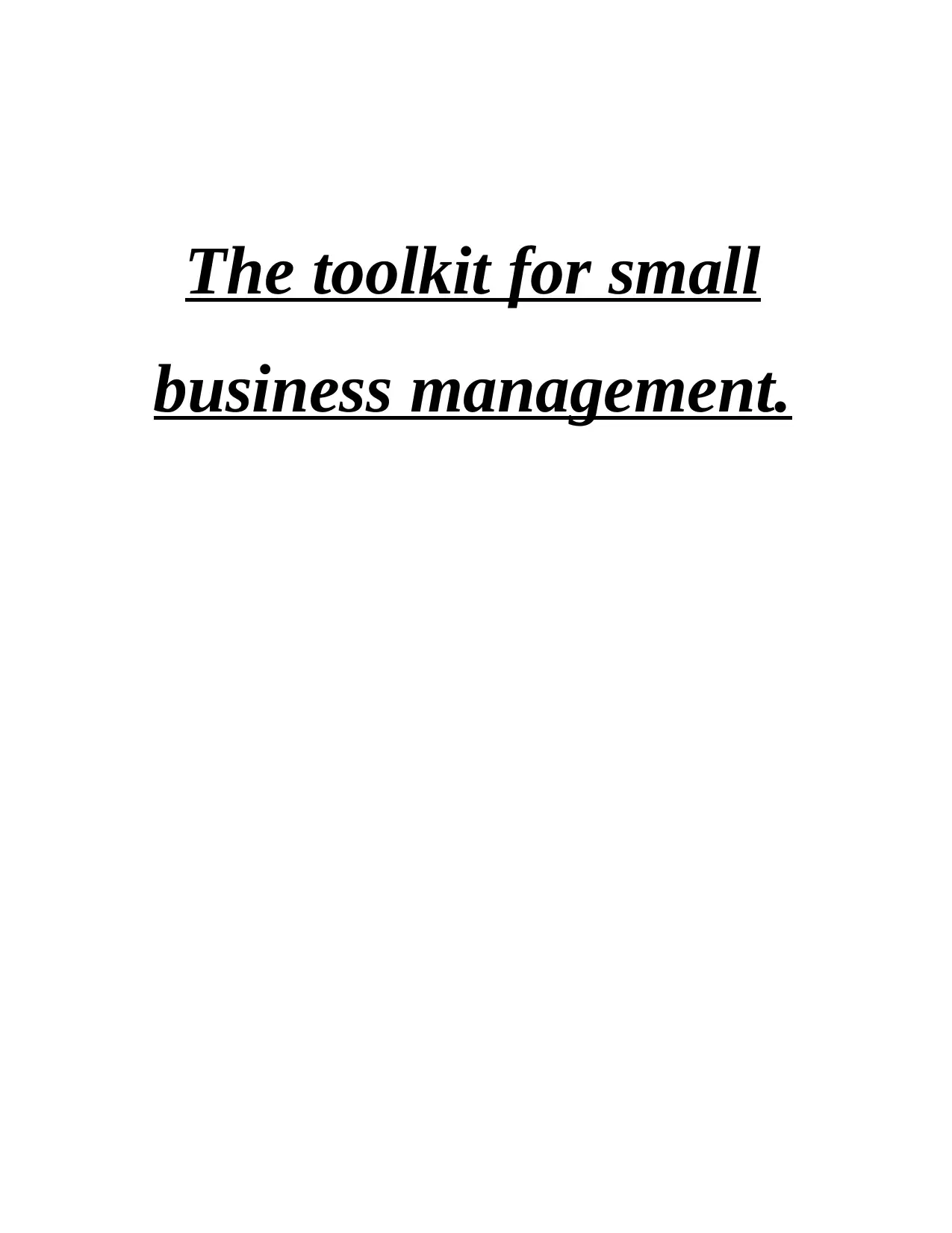
The toolkit for small
business management.
business management.
Paraphrase This Document
Need a fresh take? Get an instant paraphrase of this document with our AI Paraphraser
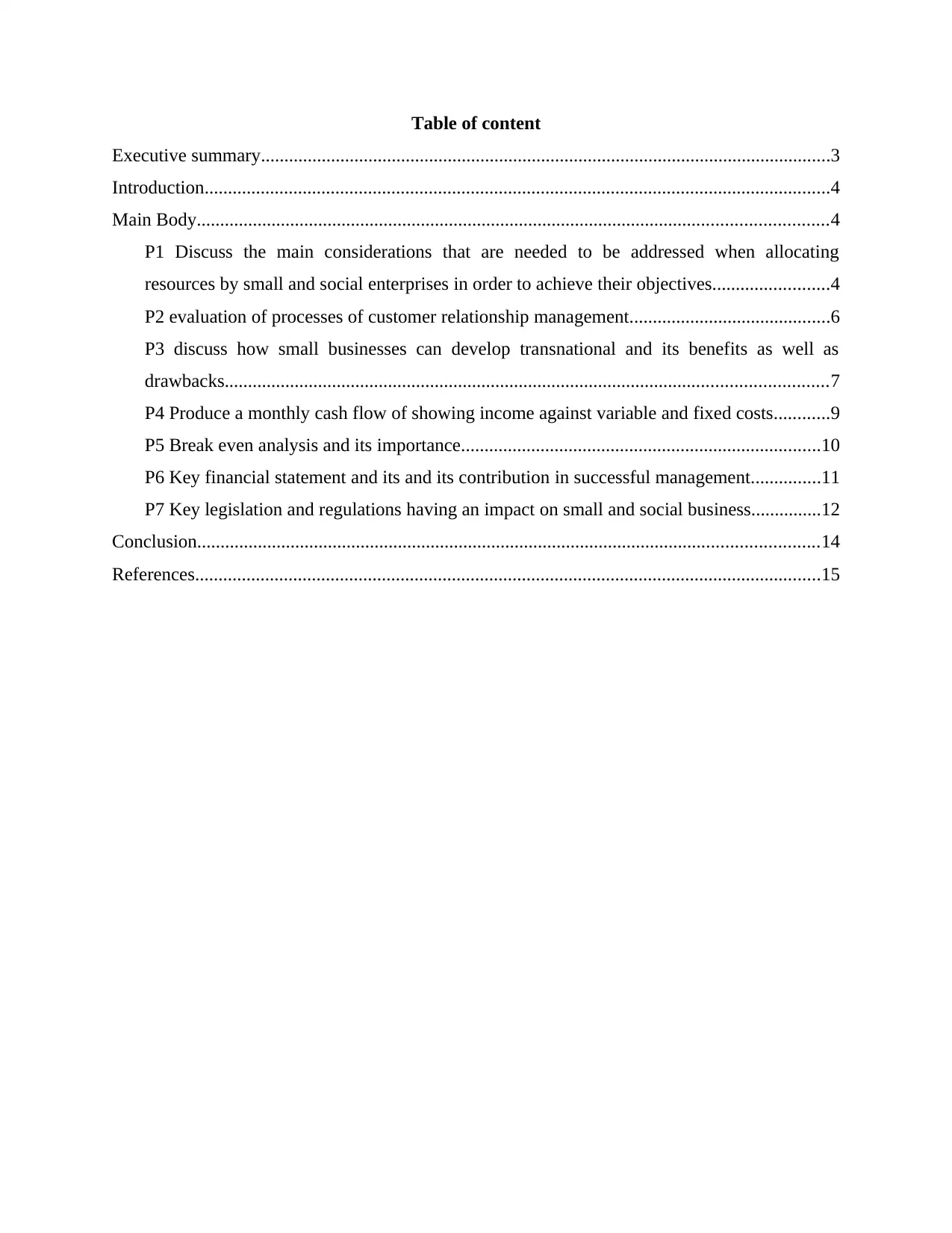
Table of content
Executive summary..........................................................................................................................3
Introduction......................................................................................................................................4
Main Body.......................................................................................................................................4
P1 Discuss the main considerations that are needed to be addressed when allocating
resources by small and social enterprises in order to achieve their objectives.........................4
P2 evaluation of processes of customer relationship management...........................................6
P3 discuss how small businesses can develop transnational and its benefits as well as
drawbacks.................................................................................................................................7
P4 Produce a monthly cash flow of showing income against variable and fixed costs............9
P5 Break even analysis and its importance.............................................................................10
P6 Key financial statement and its and its contribution in successful management...............11
P7 Key legislation and regulations having an impact on small and social business...............12
Conclusion.....................................................................................................................................14
References......................................................................................................................................15
Executive summary..........................................................................................................................3
Introduction......................................................................................................................................4
Main Body.......................................................................................................................................4
P1 Discuss the main considerations that are needed to be addressed when allocating
resources by small and social enterprises in order to achieve their objectives.........................4
P2 evaluation of processes of customer relationship management...........................................6
P3 discuss how small businesses can develop transnational and its benefits as well as
drawbacks.................................................................................................................................7
P4 Produce a monthly cash flow of showing income against variable and fixed costs............9
P5 Break even analysis and its importance.............................................................................10
P6 Key financial statement and its and its contribution in successful management...............11
P7 Key legislation and regulations having an impact on small and social business...............12
Conclusion.....................................................................................................................................14
References......................................................................................................................................15
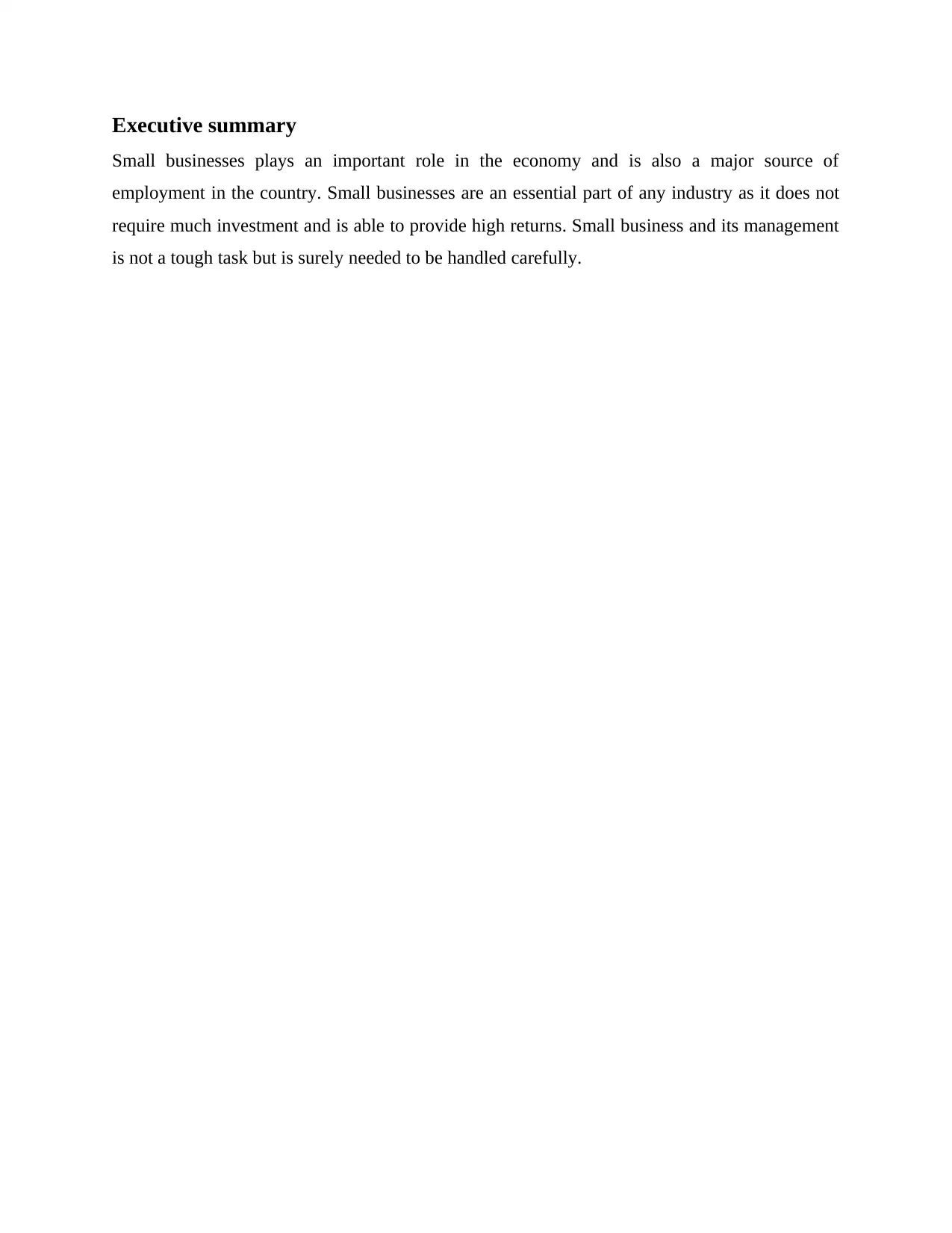
Executive summary
Small businesses plays an important role in the economy and is also a major source of
employment in the country. Small businesses are an essential part of any industry as it does not
require much investment and is able to provide high returns. Small business and its management
is not a tough task but is surely needed to be handled carefully.
Small businesses plays an important role in the economy and is also a major source of
employment in the country. Small businesses are an essential part of any industry as it does not
require much investment and is able to provide high returns. Small business and its management
is not a tough task but is surely needed to be handled carefully.
⊘ This is a preview!⊘
Do you want full access?
Subscribe today to unlock all pages.

Trusted by 1+ million students worldwide
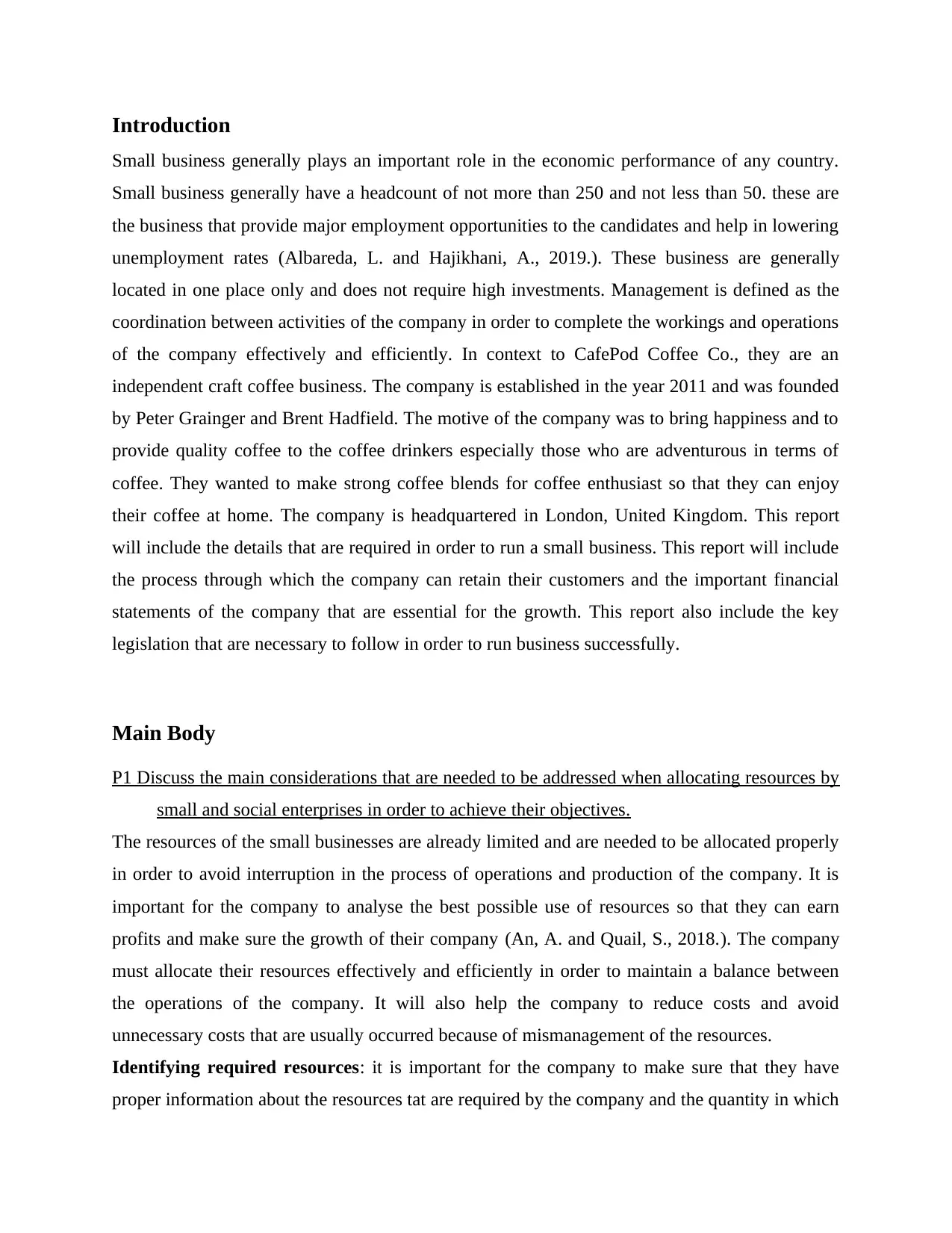
Introduction
Small business generally plays an important role in the economic performance of any country.
Small business generally have a headcount of not more than 250 and not less than 50. these are
the business that provide major employment opportunities to the candidates and help in lowering
unemployment rates (Albareda, L. and Hajikhani, A., 2019.). These business are generally
located in one place only and does not require high investments. Management is defined as the
coordination between activities of the company in order to complete the workings and operations
of the company effectively and efficiently. In context to CafePod Coffee Co., they are an
independent craft coffee business. The company is established in the year 2011 and was founded
by Peter Grainger and Brent Hadfield. The motive of the company was to bring happiness and to
provide quality coffee to the coffee drinkers especially those who are adventurous in terms of
coffee. They wanted to make strong coffee blends for coffee enthusiast so that they can enjoy
their coffee at home. The company is headquartered in London, United Kingdom. This report
will include the details that are required in order to run a small business. This report will include
the process through which the company can retain their customers and the important financial
statements of the company that are essential for the growth. This report also include the key
legislation that are necessary to follow in order to run business successfully.
Main Body
P1 Discuss the main considerations that are needed to be addressed when allocating resources by
small and social enterprises in order to achieve their objectives.
The resources of the small businesses are already limited and are needed to be allocated properly
in order to avoid interruption in the process of operations and production of the company. It is
important for the company to analyse the best possible use of resources so that they can earn
profits and make sure the growth of their company (An, A. and Quail, S., 2018.). The company
must allocate their resources effectively and efficiently in order to maintain a balance between
the operations of the company. It will also help the company to reduce costs and avoid
unnecessary costs that are usually occurred because of mismanagement of the resources.
Identifying required resources: it is important for the company to make sure that they have
proper information about the resources tat are required by the company and the quantity in which
Small business generally plays an important role in the economic performance of any country.
Small business generally have a headcount of not more than 250 and not less than 50. these are
the business that provide major employment opportunities to the candidates and help in lowering
unemployment rates (Albareda, L. and Hajikhani, A., 2019.). These business are generally
located in one place only and does not require high investments. Management is defined as the
coordination between activities of the company in order to complete the workings and operations
of the company effectively and efficiently. In context to CafePod Coffee Co., they are an
independent craft coffee business. The company is established in the year 2011 and was founded
by Peter Grainger and Brent Hadfield. The motive of the company was to bring happiness and to
provide quality coffee to the coffee drinkers especially those who are adventurous in terms of
coffee. They wanted to make strong coffee blends for coffee enthusiast so that they can enjoy
their coffee at home. The company is headquartered in London, United Kingdom. This report
will include the details that are required in order to run a small business. This report will include
the process through which the company can retain their customers and the important financial
statements of the company that are essential for the growth. This report also include the key
legislation that are necessary to follow in order to run business successfully.
Main Body
P1 Discuss the main considerations that are needed to be addressed when allocating resources by
small and social enterprises in order to achieve their objectives.
The resources of the small businesses are already limited and are needed to be allocated properly
in order to avoid interruption in the process of operations and production of the company. It is
important for the company to analyse the best possible use of resources so that they can earn
profits and make sure the growth of their company (An, A. and Quail, S., 2018.). The company
must allocate their resources effectively and efficiently in order to maintain a balance between
the operations of the company. It will also help the company to reduce costs and avoid
unnecessary costs that are usually occurred because of mismanagement of the resources.
Identifying required resources: it is important for the company to make sure that they have
proper information about the resources tat are required by the company and the quantity in which
Paraphrase This Document
Need a fresh take? Get an instant paraphrase of this document with our AI Paraphraser
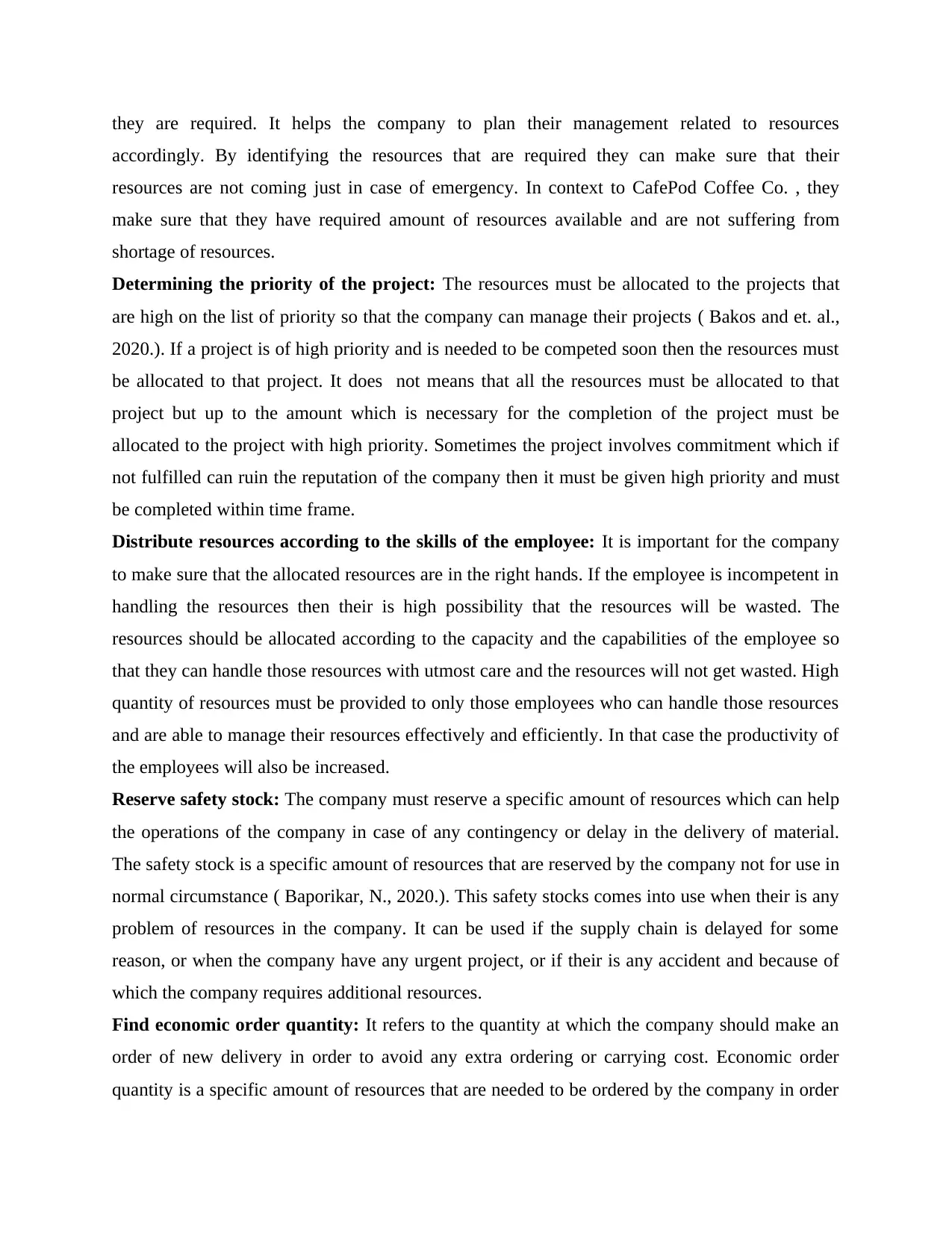
they are required. It helps the company to plan their management related to resources
accordingly. By identifying the resources that are required they can make sure that their
resources are not coming just in case of emergency. In context to CafePod Coffee Co. , they
make sure that they have required amount of resources available and are not suffering from
shortage of resources.
Determining the priority of the project: The resources must be allocated to the projects that
are high on the list of priority so that the company can manage their projects ( Bakos and et. al.,
2020.). If a project is of high priority and is needed to be competed soon then the resources must
be allocated to that project. It does not means that all the resources must be allocated to that
project but up to the amount which is necessary for the completion of the project must be
allocated to the project with high priority. Sometimes the project involves commitment which if
not fulfilled can ruin the reputation of the company then it must be given high priority and must
be completed within time frame.
Distribute resources according to the skills of the employee: It is important for the company
to make sure that the allocated resources are in the right hands. If the employee is incompetent in
handling the resources then their is high possibility that the resources will be wasted. The
resources should be allocated according to the capacity and the capabilities of the employee so
that they can handle those resources with utmost care and the resources will not get wasted. High
quantity of resources must be provided to only those employees who can handle those resources
and are able to manage their resources effectively and efficiently. In that case the productivity of
the employees will also be increased.
Reserve safety stock: The company must reserve a specific amount of resources which can help
the operations of the company in case of any contingency or delay in the delivery of material.
The safety stock is a specific amount of resources that are reserved by the company not for use in
normal circumstance ( Baporikar, N., 2020.). This safety stocks comes into use when their is any
problem of resources in the company. It can be used if the supply chain is delayed for some
reason, or when the company have any urgent project, or if their is any accident and because of
which the company requires additional resources.
Find economic order quantity: It refers to the quantity at which the company should make an
order of new delivery in order to avoid any extra ordering or carrying cost. Economic order
quantity is a specific amount of resources that are needed to be ordered by the company in order
accordingly. By identifying the resources that are required they can make sure that their
resources are not coming just in case of emergency. In context to CafePod Coffee Co. , they
make sure that they have required amount of resources available and are not suffering from
shortage of resources.
Determining the priority of the project: The resources must be allocated to the projects that
are high on the list of priority so that the company can manage their projects ( Bakos and et. al.,
2020.). If a project is of high priority and is needed to be competed soon then the resources must
be allocated to that project. It does not means that all the resources must be allocated to that
project but up to the amount which is necessary for the completion of the project must be
allocated to the project with high priority. Sometimes the project involves commitment which if
not fulfilled can ruin the reputation of the company then it must be given high priority and must
be completed within time frame.
Distribute resources according to the skills of the employee: It is important for the company
to make sure that the allocated resources are in the right hands. If the employee is incompetent in
handling the resources then their is high possibility that the resources will be wasted. The
resources should be allocated according to the capacity and the capabilities of the employee so
that they can handle those resources with utmost care and the resources will not get wasted. High
quantity of resources must be provided to only those employees who can handle those resources
and are able to manage their resources effectively and efficiently. In that case the productivity of
the employees will also be increased.
Reserve safety stock: The company must reserve a specific amount of resources which can help
the operations of the company in case of any contingency or delay in the delivery of material.
The safety stock is a specific amount of resources that are reserved by the company not for use in
normal circumstance ( Baporikar, N., 2020.). This safety stocks comes into use when their is any
problem of resources in the company. It can be used if the supply chain is delayed for some
reason, or when the company have any urgent project, or if their is any accident and because of
which the company requires additional resources.
Find economic order quantity: It refers to the quantity at which the company should make an
order of new delivery in order to avoid any extra ordering or carrying cost. Economic order
quantity is a specific amount of resources that are needed to be ordered by the company in order
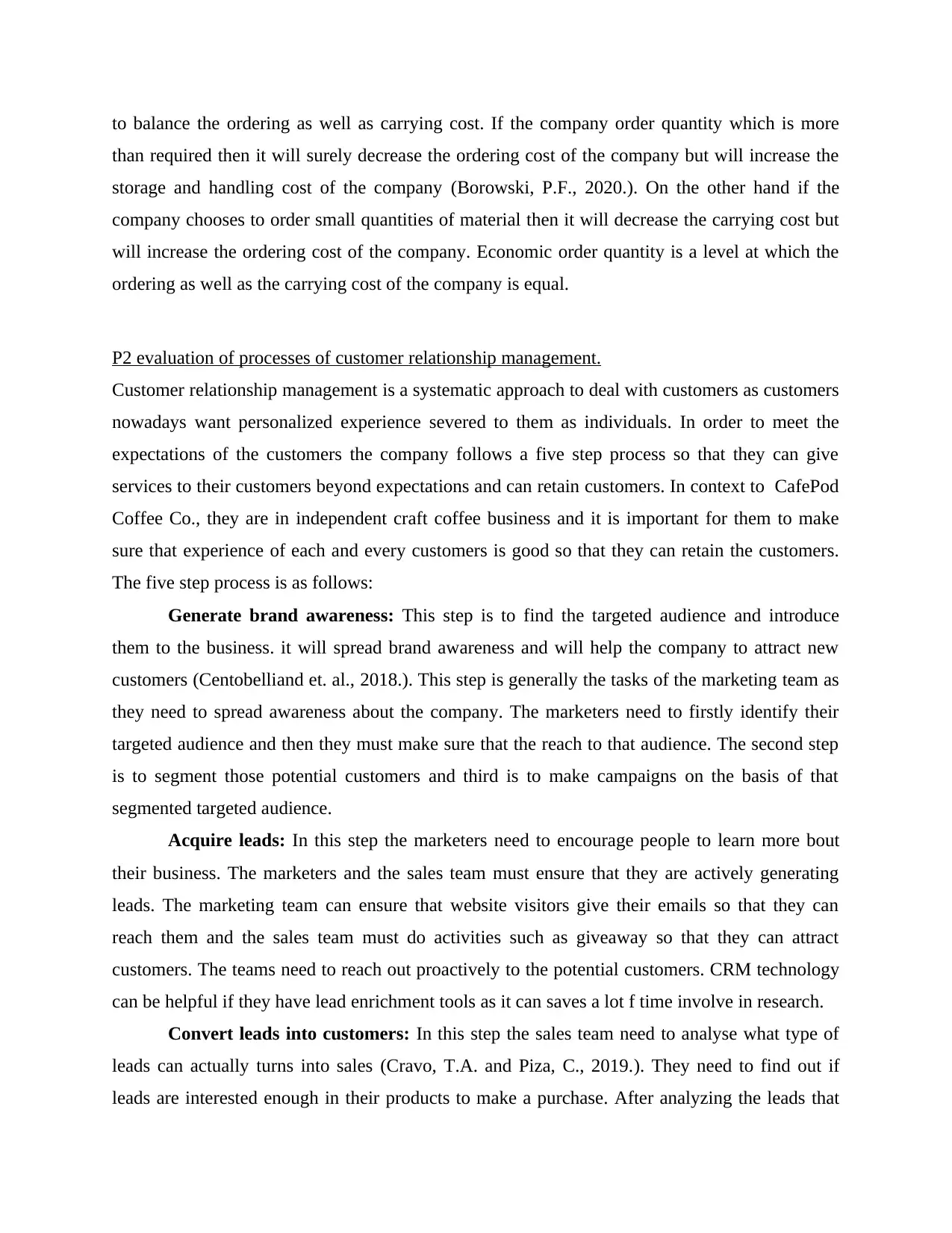
to balance the ordering as well as carrying cost. If the company order quantity which is more
than required then it will surely decrease the ordering cost of the company but will increase the
storage and handling cost of the company (Borowski, P.F., 2020.). On the other hand if the
company chooses to order small quantities of material then it will decrease the carrying cost but
will increase the ordering cost of the company. Economic order quantity is a level at which the
ordering as well as the carrying cost of the company is equal.
P2 evaluation of processes of customer relationship management.
Customer relationship management is a systematic approach to deal with customers as customers
nowadays want personalized experience severed to them as individuals. In order to meet the
expectations of the customers the company follows a five step process so that they can give
services to their customers beyond expectations and can retain customers. In context to CafePod
Coffee Co., they are in independent craft coffee business and it is important for them to make
sure that experience of each and every customers is good so that they can retain the customers.
The five step process is as follows:
Generate brand awareness: This step is to find the targeted audience and introduce
them to the business. it will spread brand awareness and will help the company to attract new
customers (Centobelliand et. al., 2018.). This step is generally the tasks of the marketing team as
they need to spread awareness about the company. The marketers need to firstly identify their
targeted audience and then they must make sure that the reach to that audience. The second step
is to segment those potential customers and third is to make campaigns on the basis of that
segmented targeted audience.
Acquire leads: In this step the marketers need to encourage people to learn more bout
their business. The marketers and the sales team must ensure that they are actively generating
leads. The marketing team can ensure that website visitors give their emails so that they can
reach them and the sales team must do activities such as giveaway so that they can attract
customers. The teams need to reach out proactively to the potential customers. CRM technology
can be helpful if they have lead enrichment tools as it can saves a lot f time involve in research.
Convert leads into customers: In this step the sales team need to analyse what type of
leads can actually turns into sales (Cravo, T.A. and Piza, C., 2019.). They need to find out if
leads are interested enough in their products to make a purchase. After analyzing the leads that
than required then it will surely decrease the ordering cost of the company but will increase the
storage and handling cost of the company (Borowski, P.F., 2020.). On the other hand if the
company chooses to order small quantities of material then it will decrease the carrying cost but
will increase the ordering cost of the company. Economic order quantity is a level at which the
ordering as well as the carrying cost of the company is equal.
P2 evaluation of processes of customer relationship management.
Customer relationship management is a systematic approach to deal with customers as customers
nowadays want personalized experience severed to them as individuals. In order to meet the
expectations of the customers the company follows a five step process so that they can give
services to their customers beyond expectations and can retain customers. In context to CafePod
Coffee Co., they are in independent craft coffee business and it is important for them to make
sure that experience of each and every customers is good so that they can retain the customers.
The five step process is as follows:
Generate brand awareness: This step is to find the targeted audience and introduce
them to the business. it will spread brand awareness and will help the company to attract new
customers (Centobelliand et. al., 2018.). This step is generally the tasks of the marketing team as
they need to spread awareness about the company. The marketers need to firstly identify their
targeted audience and then they must make sure that the reach to that audience. The second step
is to segment those potential customers and third is to make campaigns on the basis of that
segmented targeted audience.
Acquire leads: In this step the marketers need to encourage people to learn more bout
their business. The marketers and the sales team must ensure that they are actively generating
leads. The marketing team can ensure that website visitors give their emails so that they can
reach them and the sales team must do activities such as giveaway so that they can attract
customers. The teams need to reach out proactively to the potential customers. CRM technology
can be helpful if they have lead enrichment tools as it can saves a lot f time involve in research.
Convert leads into customers: In this step the sales team need to analyse what type of
leads can actually turns into sales (Cravo, T.A. and Piza, C., 2019.). They need to find out if
leads are interested enough in their products to make a purchase. After analyzing the leads that
⊘ This is a preview!⊘
Do you want full access?
Subscribe today to unlock all pages.

Trusted by 1+ million students worldwide
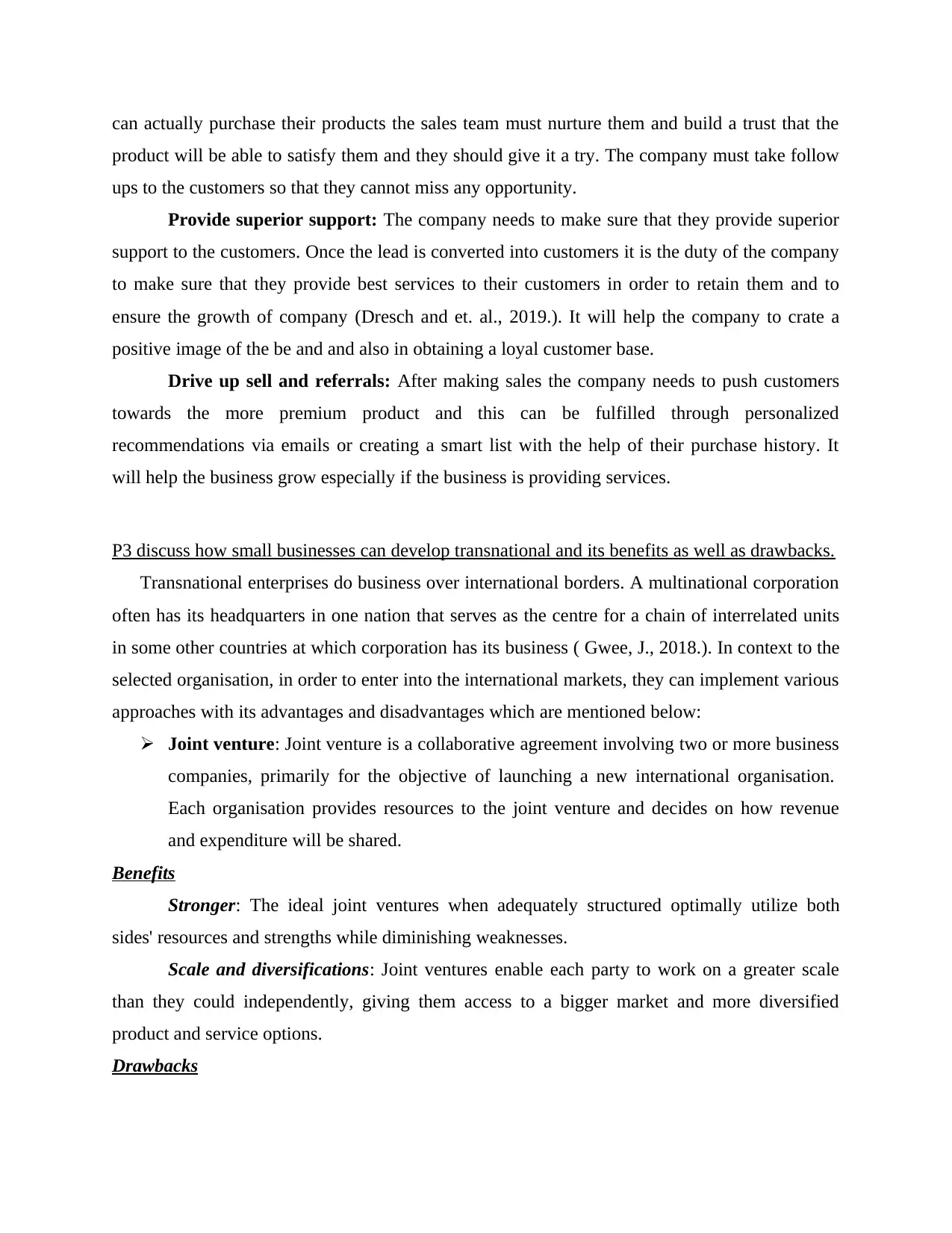
can actually purchase their products the sales team must nurture them and build a trust that the
product will be able to satisfy them and they should give it a try. The company must take follow
ups to the customers so that they cannot miss any opportunity.
Provide superior support: The company needs to make sure that they provide superior
support to the customers. Once the lead is converted into customers it is the duty of the company
to make sure that they provide best services to their customers in order to retain them and to
ensure the growth of company (Dresch and et. al., 2019.). It will help the company to crate a
positive image of the be and and also in obtaining a loyal customer base.
Drive up sell and referrals: After making sales the company needs to push customers
towards the more premium product and this can be fulfilled through personalized
recommendations via emails or creating a smart list with the help of their purchase history. It
will help the business grow especially if the business is providing services.
P3 discuss how small businesses can develop transnational and its benefits as well as drawbacks.
Transnational enterprises do business over international borders. A multinational corporation
often has its headquarters in one nation that serves as the centre for a chain of interrelated units
in some other countries at which corporation has its business ( Gwee, J., 2018.). In context to the
selected organisation, in order to enter into the international markets, they can implement various
approaches with its advantages and disadvantages which are mentioned below:
Joint venture: Joint venture is a collaborative agreement involving two or more business
companies, primarily for the objective of launching a new international organisation.
Each organisation provides resources to the joint venture and decides on how revenue
and expenditure will be shared.
Benefits
Stronger: The ideal joint ventures when adequately structured optimally utilize both
sides' resources and strengths while diminishing weaknesses.
Scale and diversifications: Joint ventures enable each party to work on a greater scale
than they could independently, giving them access to a bigger market and more diversified
product and service options.
Drawbacks
product will be able to satisfy them and they should give it a try. The company must take follow
ups to the customers so that they cannot miss any opportunity.
Provide superior support: The company needs to make sure that they provide superior
support to the customers. Once the lead is converted into customers it is the duty of the company
to make sure that they provide best services to their customers in order to retain them and to
ensure the growth of company (Dresch and et. al., 2019.). It will help the company to crate a
positive image of the be and and also in obtaining a loyal customer base.
Drive up sell and referrals: After making sales the company needs to push customers
towards the more premium product and this can be fulfilled through personalized
recommendations via emails or creating a smart list with the help of their purchase history. It
will help the business grow especially if the business is providing services.
P3 discuss how small businesses can develop transnational and its benefits as well as drawbacks.
Transnational enterprises do business over international borders. A multinational corporation
often has its headquarters in one nation that serves as the centre for a chain of interrelated units
in some other countries at which corporation has its business ( Gwee, J., 2018.). In context to the
selected organisation, in order to enter into the international markets, they can implement various
approaches with its advantages and disadvantages which are mentioned below:
Joint venture: Joint venture is a collaborative agreement involving two or more business
companies, primarily for the objective of launching a new international organisation.
Each organisation provides resources to the joint venture and decides on how revenue
and expenditure will be shared.
Benefits
Stronger: The ideal joint ventures when adequately structured optimally utilize both
sides' resources and strengths while diminishing weaknesses.
Scale and diversifications: Joint ventures enable each party to work on a greater scale
than they could independently, giving them access to a bigger market and more diversified
product and service options.
Drawbacks
Paraphrase This Document
Need a fresh take? Get an instant paraphrase of this document with our AI Paraphraser
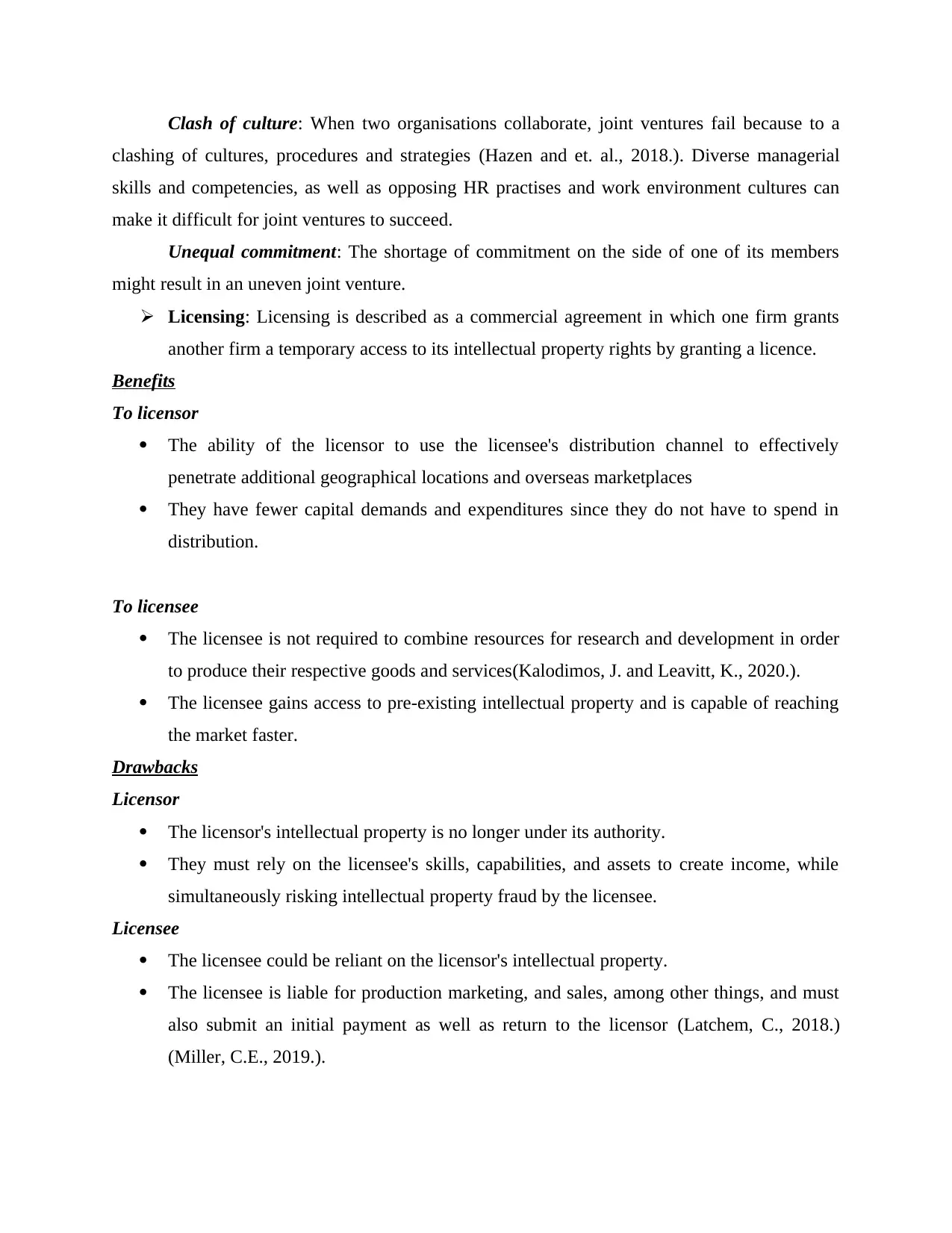
Clash of culture: When two organisations collaborate, joint ventures fail because to a
clashing of cultures, procedures and strategies (Hazen and et. al., 2018.). Diverse managerial
skills and competencies, as well as opposing HR practises and work environment cultures can
make it difficult for joint ventures to succeed.
Unequal commitment: The shortage of commitment on the side of one of its members
might result in an uneven joint venture.
Licensing: Licensing is described as a commercial agreement in which one firm grants
another firm a temporary access to its intellectual property rights by granting a licence.
Benefits
To licensor
The ability of the licensor to use the licensee's distribution channel to effectively
penetrate additional geographical locations and overseas marketplaces
They have fewer capital demands and expenditures since they do not have to spend in
distribution.
To licensee
The licensee is not required to combine resources for research and development in order
to produce their respective goods and services(Kalodimos, J. and Leavitt, K., 2020.).
The licensee gains access to pre-existing intellectual property and is capable of reaching
the market faster.
Drawbacks
Licensor
The licensor's intellectual property is no longer under its authority.
They must rely on the licensee's skills, capabilities, and assets to create income, while
simultaneously risking intellectual property fraud by the licensee.
Licensee
The licensee could be reliant on the licensor's intellectual property.
The licensee is liable for production marketing, and sales, among other things, and must
also submit an initial payment as well as return to the licensor (Latchem, C., 2018.)
(Miller, C.E., 2019.).
clashing of cultures, procedures and strategies (Hazen and et. al., 2018.). Diverse managerial
skills and competencies, as well as opposing HR practises and work environment cultures can
make it difficult for joint ventures to succeed.
Unequal commitment: The shortage of commitment on the side of one of its members
might result in an uneven joint venture.
Licensing: Licensing is described as a commercial agreement in which one firm grants
another firm a temporary access to its intellectual property rights by granting a licence.
Benefits
To licensor
The ability of the licensor to use the licensee's distribution channel to effectively
penetrate additional geographical locations and overseas marketplaces
They have fewer capital demands and expenditures since they do not have to spend in
distribution.
To licensee
The licensee is not required to combine resources for research and development in order
to produce their respective goods and services(Kalodimos, J. and Leavitt, K., 2020.).
The licensee gains access to pre-existing intellectual property and is capable of reaching
the market faster.
Drawbacks
Licensor
The licensor's intellectual property is no longer under its authority.
They must rely on the licensee's skills, capabilities, and assets to create income, while
simultaneously risking intellectual property fraud by the licensee.
Licensee
The licensee could be reliant on the licensor's intellectual property.
The licensee is liable for production marketing, and sales, among other things, and must
also submit an initial payment as well as return to the licensor (Latchem, C., 2018.)
(Miller, C.E., 2019.).
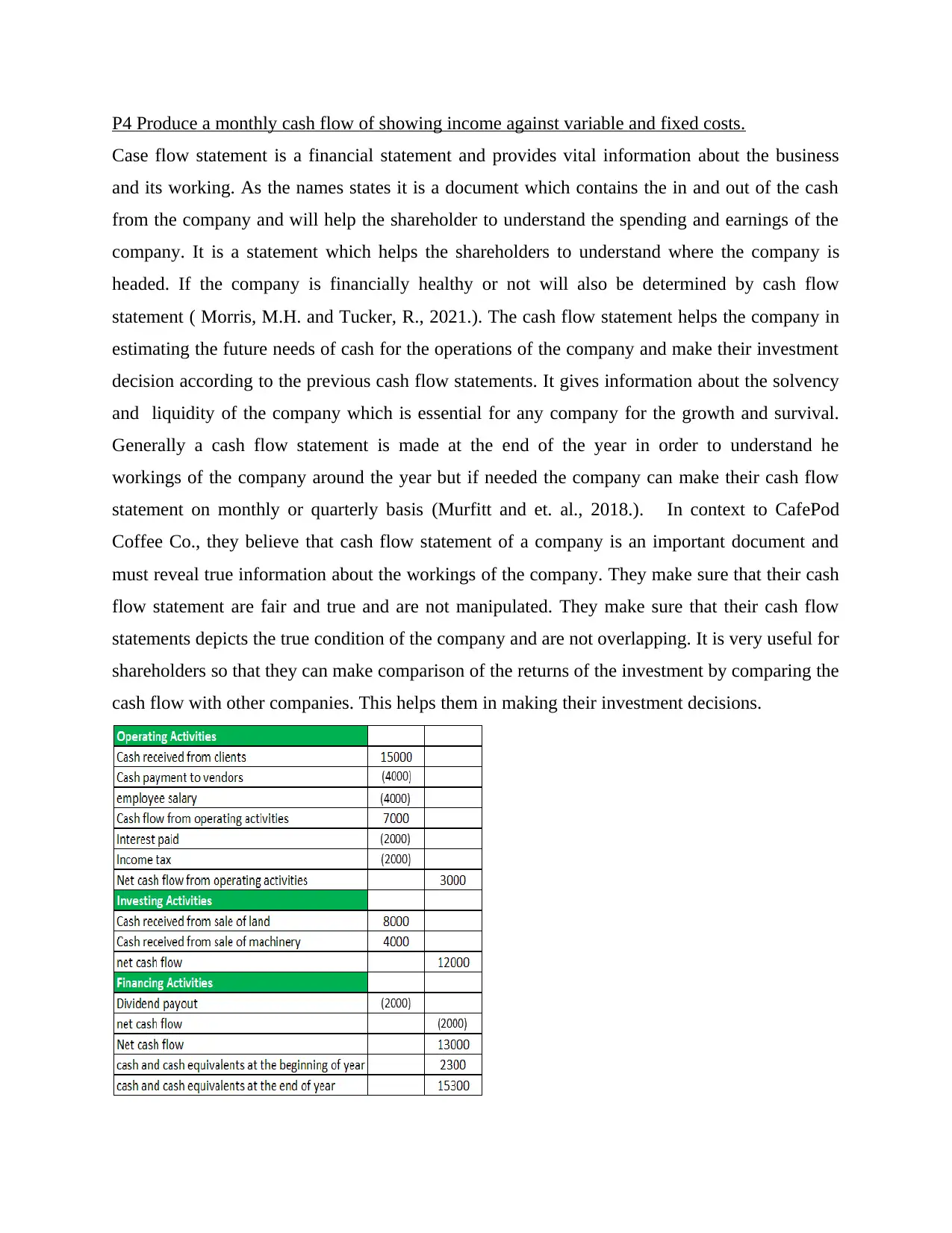
P4 Produce a monthly cash flow of showing income against variable and fixed costs.
Case flow statement is a financial statement and provides vital information about the business
and its working. As the names states it is a document which contains the in and out of the cash
from the company and will help the shareholder to understand the spending and earnings of the
company. It is a statement which helps the shareholders to understand where the company is
headed. If the company is financially healthy or not will also be determined by cash flow
statement ( Morris, M.H. and Tucker, R., 2021.). The cash flow statement helps the company in
estimating the future needs of cash for the operations of the company and make their investment
decision according to the previous cash flow statements. It gives information about the solvency
and liquidity of the company which is essential for any company for the growth and survival.
Generally a cash flow statement is made at the end of the year in order to understand he
workings of the company around the year but if needed the company can make their cash flow
statement on monthly or quarterly basis (Murfitt and et. al., 2018.). In context to CafePod
Coffee Co., they believe that cash flow statement of a company is an important document and
must reveal true information about the workings of the company. They make sure that their cash
flow statement are fair and true and are not manipulated. They make sure that their cash flow
statements depicts the true condition of the company and are not overlapping. It is very useful for
shareholders so that they can make comparison of the returns of the investment by comparing the
cash flow with other companies. This helps them in making their investment decisions.
Case flow statement is a financial statement and provides vital information about the business
and its working. As the names states it is a document which contains the in and out of the cash
from the company and will help the shareholder to understand the spending and earnings of the
company. It is a statement which helps the shareholders to understand where the company is
headed. If the company is financially healthy or not will also be determined by cash flow
statement ( Morris, M.H. and Tucker, R., 2021.). The cash flow statement helps the company in
estimating the future needs of cash for the operations of the company and make their investment
decision according to the previous cash flow statements. It gives information about the solvency
and liquidity of the company which is essential for any company for the growth and survival.
Generally a cash flow statement is made at the end of the year in order to understand he
workings of the company around the year but if needed the company can make their cash flow
statement on monthly or quarterly basis (Murfitt and et. al., 2018.). In context to CafePod
Coffee Co., they believe that cash flow statement of a company is an important document and
must reveal true information about the workings of the company. They make sure that their cash
flow statement are fair and true and are not manipulated. They make sure that their cash flow
statements depicts the true condition of the company and are not overlapping. It is very useful for
shareholders so that they can make comparison of the returns of the investment by comparing the
cash flow with other companies. This helps them in making their investment decisions.
⊘ This is a preview!⊘
Do you want full access?
Subscribe today to unlock all pages.

Trusted by 1+ million students worldwide
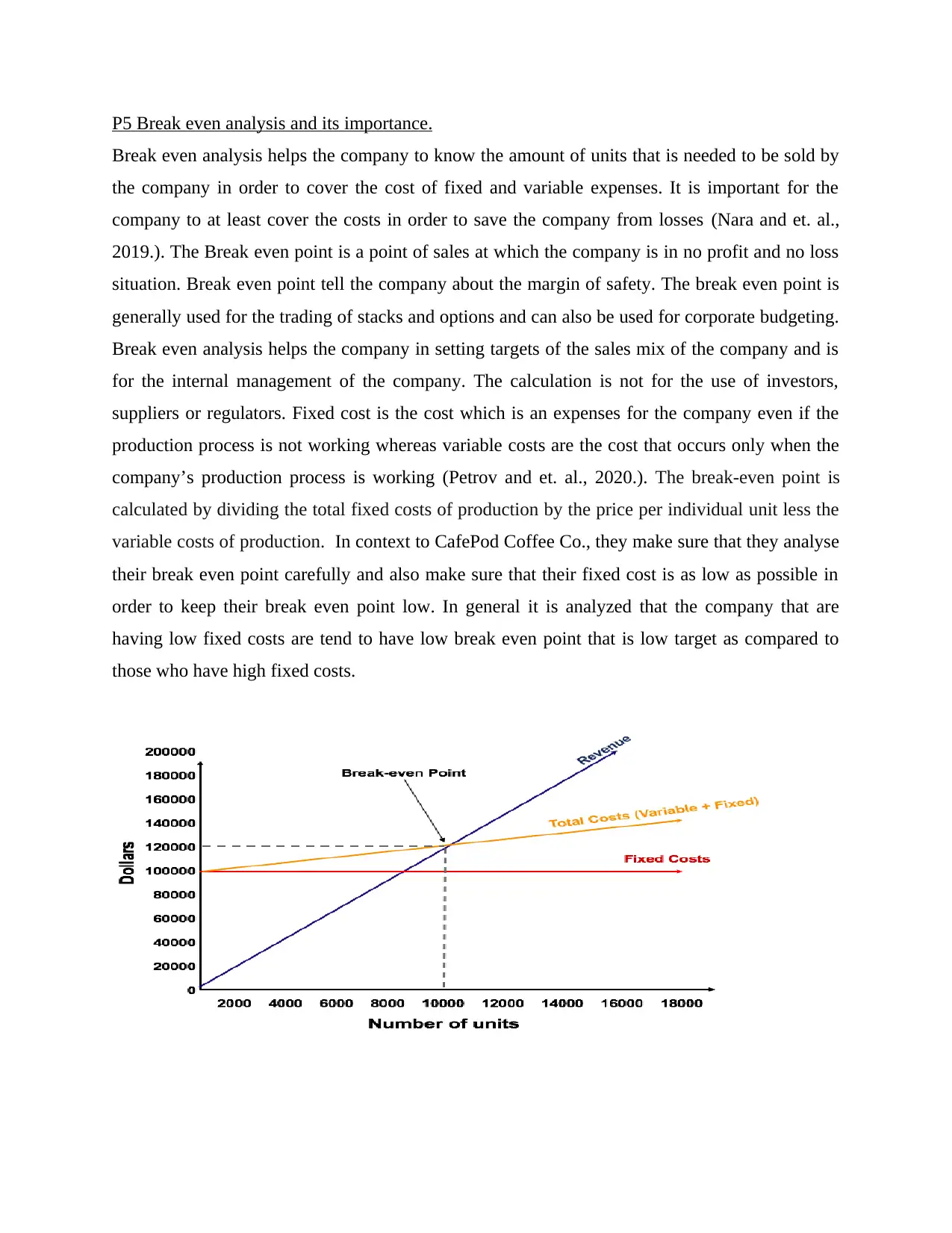
P5 Break even analysis and its importance.
Break even analysis helps the company to know the amount of units that is needed to be sold by
the company in order to cover the cost of fixed and variable expenses. It is important for the
company to at least cover the costs in order to save the company from losses (Nara and et. al.,
2019.). The Break even point is a point of sales at which the company is in no profit and no loss
situation. Break even point tell the company about the margin of safety. The break even point is
generally used for the trading of stacks and options and can also be used for corporate budgeting.
Break even analysis helps the company in setting targets of the sales mix of the company and is
for the internal management of the company. The calculation is not for the use of investors,
suppliers or regulators. Fixed cost is the cost which is an expenses for the company even if the
production process is not working whereas variable costs are the cost that occurs only when the
company’s production process is working (Petrov and et. al., 2020.). The break-even point is
calculated by dividing the total fixed costs of production by the price per individual unit less the
variable costs of production. In context to CafePod Coffee Co., they make sure that they analyse
their break even point carefully and also make sure that their fixed cost is as low as possible in
order to keep their break even point low. In general it is analyzed that the company that are
having low fixed costs are tend to have low break even point that is low target as compared to
those who have high fixed costs.
Break even analysis helps the company to know the amount of units that is needed to be sold by
the company in order to cover the cost of fixed and variable expenses. It is important for the
company to at least cover the costs in order to save the company from losses (Nara and et. al.,
2019.). The Break even point is a point of sales at which the company is in no profit and no loss
situation. Break even point tell the company about the margin of safety. The break even point is
generally used for the trading of stacks and options and can also be used for corporate budgeting.
Break even analysis helps the company in setting targets of the sales mix of the company and is
for the internal management of the company. The calculation is not for the use of investors,
suppliers or regulators. Fixed cost is the cost which is an expenses for the company even if the
production process is not working whereas variable costs are the cost that occurs only when the
company’s production process is working (Petrov and et. al., 2020.). The break-even point is
calculated by dividing the total fixed costs of production by the price per individual unit less the
variable costs of production. In context to CafePod Coffee Co., they make sure that they analyse
their break even point carefully and also make sure that their fixed cost is as low as possible in
order to keep their break even point low. In general it is analyzed that the company that are
having low fixed costs are tend to have low break even point that is low target as compared to
those who have high fixed costs.
Paraphrase This Document
Need a fresh take? Get an instant paraphrase of this document with our AI Paraphraser
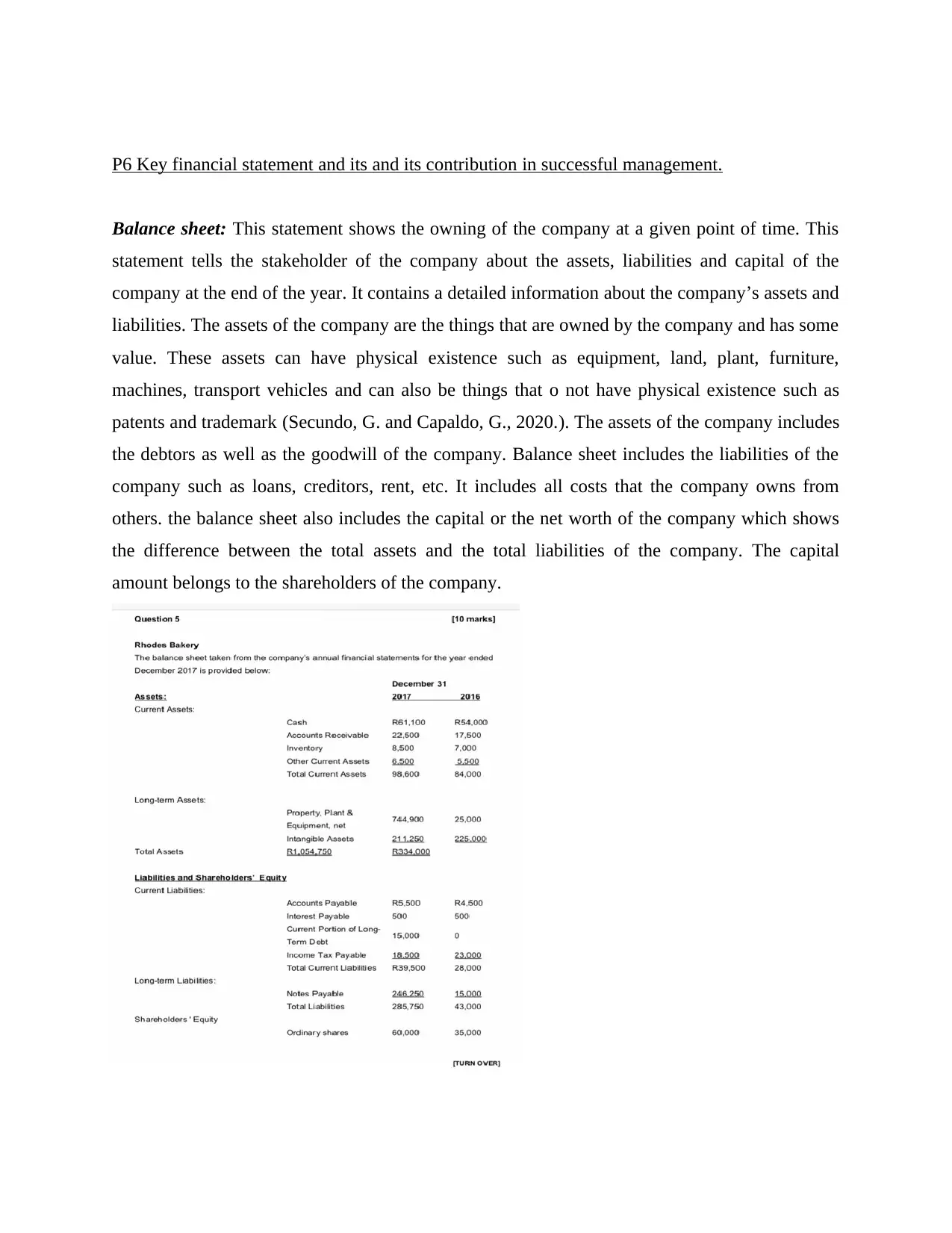
P6 Key financial statement and its and its contribution in successful management.
Balance sheet: This statement shows the owning of the company at a given point of time. This
statement tells the stakeholder of the company about the assets, liabilities and capital of the
company at the end of the year. It contains a detailed information about the company’s assets and
liabilities. The assets of the company are the things that are owned by the company and has some
value. These assets can have physical existence such as equipment, land, plant, furniture,
machines, transport vehicles and can also be things that o not have physical existence such as
patents and trademark (Secundo, G. and Capaldo, G., 2020.). The assets of the company includes
the debtors as well as the goodwill of the company. Balance sheet includes the liabilities of the
company such as loans, creditors, rent, etc. It includes all costs that the company owns from
others. the balance sheet also includes the capital or the net worth of the company which shows
the difference between the total assets and the total liabilities of the company. The capital
amount belongs to the shareholders of the company.
Balance sheet: This statement shows the owning of the company at a given point of time. This
statement tells the stakeholder of the company about the assets, liabilities and capital of the
company at the end of the year. It contains a detailed information about the company’s assets and
liabilities. The assets of the company are the things that are owned by the company and has some
value. These assets can have physical existence such as equipment, land, plant, furniture,
machines, transport vehicles and can also be things that o not have physical existence such as
patents and trademark (Secundo, G. and Capaldo, G., 2020.). The assets of the company includes
the debtors as well as the goodwill of the company. Balance sheet includes the liabilities of the
company such as loans, creditors, rent, etc. It includes all costs that the company owns from
others. the balance sheet also includes the capital or the net worth of the company which shows
the difference between the total assets and the total liabilities of the company. The capital
amount belongs to the shareholders of the company.
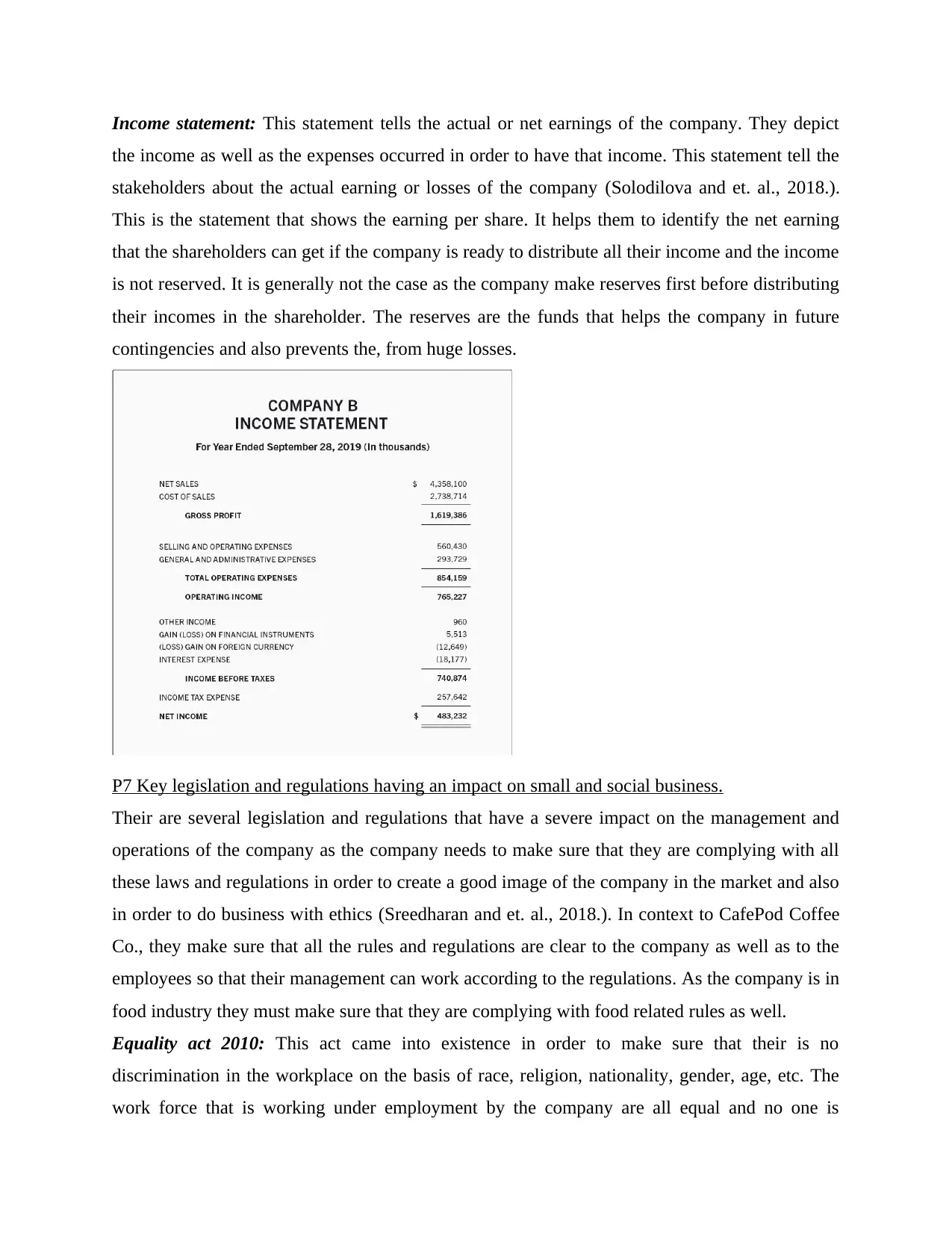
Income statement: This statement tells the actual or net earnings of the company. They depict
the income as well as the expenses occurred in order to have that income. This statement tell the
stakeholders about the actual earning or losses of the company (Solodilova and et. al., 2018.).
This is the statement that shows the earning per share. It helps them to identify the net earning
that the shareholders can get if the company is ready to distribute all their income and the income
is not reserved. It is generally not the case as the company make reserves first before distributing
their incomes in the shareholder. The reserves are the funds that helps the company in future
contingencies and also prevents the, from huge losses.
P7 Key legislation and regulations having an impact on small and social business.
Their are several legislation and regulations that have a severe impact on the management and
operations of the company as the company needs to make sure that they are complying with all
these laws and regulations in order to create a good image of the company in the market and also
in order to do business with ethics (Sreedharan and et. al., 2018.). In context to CafePod Coffee
Co., they make sure that all the rules and regulations are clear to the company as well as to the
employees so that their management can work according to the regulations. As the company is in
food industry they must make sure that they are complying with food related rules as well.
Equality act 2010: This act came into existence in order to make sure that their is no
discrimination in the workplace on the basis of race, religion, nationality, gender, age, etc. The
work force that is working under employment by the company are all equal and no one is
the income as well as the expenses occurred in order to have that income. This statement tell the
stakeholders about the actual earning or losses of the company (Solodilova and et. al., 2018.).
This is the statement that shows the earning per share. It helps them to identify the net earning
that the shareholders can get if the company is ready to distribute all their income and the income
is not reserved. It is generally not the case as the company make reserves first before distributing
their incomes in the shareholder. The reserves are the funds that helps the company in future
contingencies and also prevents the, from huge losses.
P7 Key legislation and regulations having an impact on small and social business.
Their are several legislation and regulations that have a severe impact on the management and
operations of the company as the company needs to make sure that they are complying with all
these laws and regulations in order to create a good image of the company in the market and also
in order to do business with ethics (Sreedharan and et. al., 2018.). In context to CafePod Coffee
Co., they make sure that all the rules and regulations are clear to the company as well as to the
employees so that their management can work according to the regulations. As the company is in
food industry they must make sure that they are complying with food related rules as well.
Equality act 2010: This act came into existence in order to make sure that their is no
discrimination in the workplace on the basis of race, religion, nationality, gender, age, etc. The
work force that is working under employment by the company are all equal and no one is
⊘ This is a preview!⊘
Do you want full access?
Subscribe today to unlock all pages.

Trusted by 1+ million students worldwide
1 out of 18
Related Documents
Your All-in-One AI-Powered Toolkit for Academic Success.
+13062052269
info@desklib.com
Available 24*7 on WhatsApp / Email
![[object Object]](/_next/static/media/star-bottom.7253800d.svg)
Unlock your academic potential
Copyright © 2020–2025 A2Z Services. All Rights Reserved. Developed and managed by ZUCOL.





